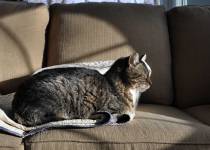We were blessed with a beautiful spring day here in Minnesota with temperatures reaching into the 50’s. Finally!
It was a gorgeous day to get outside and start checking for signs of life around the farm.
Since the snow finally started melting, Jesse decided to make his way out to the beehives to check on them. After 50 plus days this winter of high temperatures not even reaching zero degrees Fahrenheit, our expectations were very low about the likelihood that our bees survived. When our bee supplier called in January, we decided to play it safe and order two more nucs of bees to install this spring to make sure we were not left without any bees. As it turns out, we made the right decision!
We knew it was a bad sign this afternoon when Jesse pulled the covers off the hives and we saw the carnage of dead bees on the inside hive cover. There was also an eerie silence that was a tell-tale sign that the bees had not survived. It was the same scene when he opened the second hive.
No survivors. No signs of life.
We will start fresh with new bees this spring. Again.
Our snow cover was melting quickly today with the warm temperatures. The turned soil is starting to reveal itself in the plowed field next to our house. The neighbor planted a bean crop last summer and plans to re-seed an alfalfa crop this spring. This will delight our new bees.
 Wherever we wander on the farm, including out to the bees,we can always count on Sofie being somewhere close by. She is a constant sign of life on the farm, even in the bleakest of times. Dogs are such comforting companions.
Wherever we wander on the farm, including out to the bees,we can always count on Sofie being somewhere close by. She is a constant sign of life on the farm, even in the bleakest of times. Dogs are such comforting companions.
 After visiting the bees, I trudged through the heaps of piled snow to get to the edge of my vegetable garden to take a picture. With a solid foot of snow remaining within the perimeter, there is sadly no sign of life here. It is hard to imagine that in a few short months this will be green and brimming with new growth and possibilities.
After visiting the bees, I trudged through the heaps of piled snow to get to the edge of my vegetable garden to take a picture. With a solid foot of snow remaining within the perimeter, there is sadly no sign of life here. It is hard to imagine that in a few short months this will be green and brimming with new growth and possibilities.

The warm temperatures today did manage to stir awake the juices of the maple trees. We ventured in to the woods and discovered the first signs of the sap running. Although it was not a very productive day (only about 1 gallon), it is a start.
 And after this long winter, I will celebrate any sign of life that reveals itself around here!
And after this long winter, I will celebrate any sign of life that reveals itself around here!
-Lynell






















































